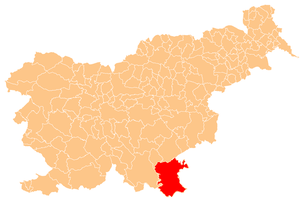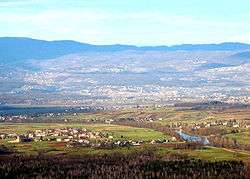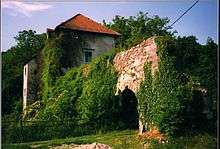White Carniola

White Carniola (Slovene: Bela krajina; German: Weißkrain or Weiße Mark) is a small traditional region in southeastern Slovenia on the border with Croatia. It is the southernmost part of the historical Lower Carniola region.[1]
Geography

The area is confined by the Gorjanci and Kočevski Rog mountain ranges in the north and west and the Kolpa River in the south and east, which also forms part of the border between Slovenia and Croatia. As the area could only be reached from northern Lower Carniola by mountain passes, the inhabitants cultivate a certain distinctness.
The region corresponds to the present-day municipalities of Metlika, Črnomelj and Semič. The terrain is characterised by low karst hills and extended birch forests. The main river is the Kolpa with its Lahinja, Dobličica and Krupa tributaries.
White Carniola is known for Grič and Kanižarica pottery from clay with a distinct calcite content, as well as for high-quality wines, such as metliška črnina (a dark red wine), belokranjec (a white wine), and modra frankinja (i.e. Blaufränkisch).
Tradition
A distinguishing part of Bela krajina is its folk heritage. It still has many folklore events, which show traditional local costumes, music, played on a regionally known instrument called tamburica, and a circle dance, called belokranjsko kolo. A distinctive feature is also the pisanica, a coloured Easter egg decorated in a characteristic manner using beeswax that is found nowhere else in Slovenia. Belokranjska pogača (Bela Krajina flatbread), a specific type of bread has recently been granted with the European Union's Traditional Speciality Guaranteed designation.[2]
Name
The name Bela krajina literally means 'white march'. The noun krajina 'march' refers to a border territory organized for military defense.[3] The adjective bela 'white' may refer to the deciduous trees (especially birch trees) in the area in comparison to "black" (i.e. coniferous)[4] trees in the neighboring Kočevje area.[3] It may also be an old designation for 'west', referring to the western location of the region in comparison to the Croatian Military Frontier (Slovene: Vojna krajina).[3] Non-linguistic explanations connect the designation bela with the traditional white linen clothing of the population.[5][6] The German designation Weißkrain (and in turn the English name White Carniola[7]) is the result of a hypercorrection based on the adjective belokrajnski (understood as a dialect metathesis of *belokranjski)[3][8] (cf. also German Dürrenkrain,[9][10] English: Dry Carniola,[11][12][13] for Slovene Suha krajina, literally 'dry region').[8]
History
Middle Ages
In the early 12th century, the area was part of the disputed border region between the Windic March and the March of Carniola, established by the Holy Roman Empire in the northwest, and the Hungarian crown lands in the Kingdom of Croatia in the southeast. From about 1127 the local counts of Višnja Gora (Weichselberg) backed by the Sponheim margraves and the Salzburg archishops crossed the Gorjanci mountains and marched against the Hungarian and Croatian forces, which they pushed beyond the Kolpa River down to Bregana.
The Counts of Weichselberg, descendants of Saint Hemma of Gurk, established the Imperial Weiße Mark ('White march') in the acquired territories. They established their residence at Metlika (Möttling), and therefore in contemporary sources their lands were also referred to as the County of Möttling. After the line became extinct in 1209, the possessions passed to the Carniolan margraves from the Bavarian House of Andechs, the Dukes of Merania, and were finally acquired for the House of Habsburg by Archduke Rudolf IV of Austria, who proclaimed himself Duke of Carniola in 1364.
Early modern period
With the Ottoman conquest of Serbian territories, groups of Serbs fled to the north or west; of the western migrational groups, some settled in White Carniola and Žumberak.[14] In September 1597, with the fall of Slatina, some 1,700 Uskoks with their wives and children settled in Carniola, bringing some 4,000 sheep with them.[15] The following year, with the conquest of Cernik, some 500 Uskok families settled in Carniola.[15] At the end of the 17th century, with the stagnation of Ottoman power due to European pressure during internal crisis, and Austrian advance far into Macedonia, Serbs armed themselves and joined the fight against the Ottomans; the Austrian retreat prompted another massive exodus of Serbs from the Ottoman territories in ca. 1690 (see Great Serb Migrations).[16]
Buildings
Castles

Several castles were built in the border region, especially during the Ottoman Wars from the 15th century onwards, as in Črnomelj, Gradac and Vinica. The remains of the large fortress in Pobrežje were destroyed in World War II.
Culture
Based on surnames found in White Carniola, it may be concluded that their ancestors were Serbs and Croats.[17] In old folk poetry of White Carniola, Serbian hero Prince Marko is often mentioned, sung in "clean Shtokavian".[17] A small Serb community exists in White Carniola.[18]
Notable people
Notable people that were born or lived in White Carniola include:
- Juro Adlešič (1884–1968), lawyer and politician, mayor of Ljubljana from 1935 to 1942
- Draga Ahačič (born 1924), actress, film director, translator, and journalist
- Andrej Bajuk (1943–2011), politician and economist
- Joe Cerne (born 1942), American football player
- Oton Gliha (born 1914), Croatian painter
- Miran Jarc (1900–1942), writer, poet, playwright, and essayist
- Lojze Krakar (1926–1995), poet, translator, editor, literary historian, and essayist
- John Vertin (1844–1899), Catholic priest, Bishop of Marquette in the US state of Michigan from 1879 to 1899
- Oton Župančič (1878–1949), poet, playwright, and translator
References
- ↑ Ferenc, Tone. 1988. "Dolenjska." Enciklopedija Slovenije, vol. 2, pp. 287–298. Ljubljana: Mladinska knjiga, p. 287.
- ↑ "Bela Krajina". Retrieved 26 August 2016.
- 1 2 3 4 Snoj, Marko. 2009. Etimološki slovar slovenskih zemljepisnih imen. Ljubljana: Modrijan and Založba ZRC, p. 55.
- ↑ Snoj, Marko. 2009. Etimološki slovar slovenskih zemljepisnih imen. Ljubljana: Modrijan and Založba ZRC, p. 101.
- ↑ Lah, Iva. 1928. "Župančičeva mladina." In: Albrecht, Fran (ed.)Jubilejni zbornik za petdesetletnico Otona Župančiča (pp. 85–90). Ljubljana: Tiskovna zadruga, p. 86.
- ↑ Longley, Norm. 2007. The Rough Guide to Slovenia. London: Rough Guides, p. 233.
- ↑ Copeland, Fanny S. 1931. "Slovene Folklore" Folklore: A Quarterly Review of Myth, Tradition, Institution & Custom 42(4): 405–446, p. 431.
- 1 2 Koštiál, Ivan. 1930. "Jezikovne drobtine." Ljubljanski zvon 50(3): 179–180, p. 180.
- ↑ Reichenbach, Anton Benedict. 1848. Neueste Volks-Naturgeschichte des Thierreichs für Schule und Haus. Leipzig: Slawische Buchhandlung, p. 58.
- ↑ Wessely, Josef. 1853. Die oesterreichischen Alpenlaender und ihre Forste. Vienna: Braumüller, p. 2.
- ↑ Büsching, Anton Friedrich. 1762. A New System of Geography. Vol. 4. Trans. P. Murdoch. London: A. Millar, p. 214.
- ↑ Smollett, Tobias George. 1769. The Present State of All Nations. London: Baldwin, p. 244.
- ↑ Moodie, Arthur Edward. 1945. The Italo-Yugoslav Boundary: A Study in Political Geography. London: G. Philip & Son, p. 32.
- ↑ Glasnik Etnografskog instituta. 52. Научно дело. 2004. p. 189.
- 1 2 Akademija nauka i umjetnosti Bosne i Hercegovine. Odjeljenje društvenih nauka (1970). Radovi odjeljenje društvenih nauka. 12. p. 158.
- ↑ Etnografski institut (Srpska akademija nauka i umetnosti) (1960). Posebna izdanja. 10–14. Naučno delo. p. 16.
- 1 2 Prosvjeta: mjesečnik Srpskog kulturnog društva Prosvjeta. Društvo. 1969. pp. 8–10.
- ↑ Subašić, B. (2014-01-29). "Belu Krajinu nema ko da čuva" (in Serbian). Novosti.
External links
 Media related to White Carniola at Wikimedia Commons
Media related to White Carniola at Wikimedia Commons
Coordinates: 45°34′0″N 15°12′0″E / 45.56667°N 15.20000°E